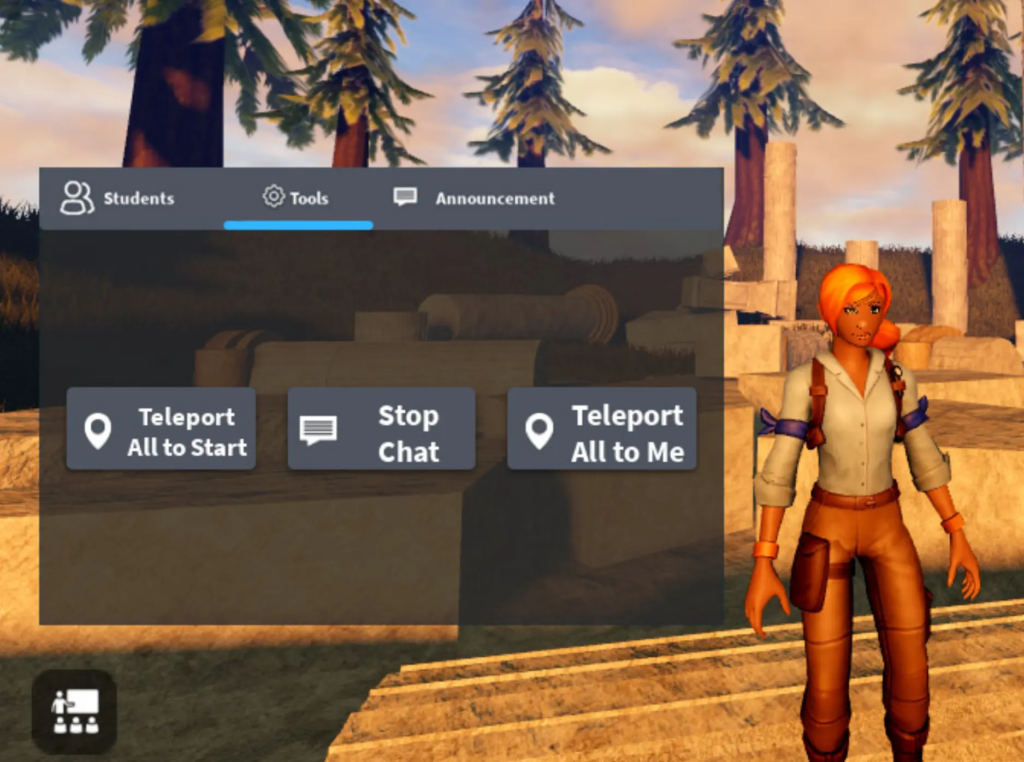Earlier this year at RDC 2023, BuilderMan, the founder of Roblox announced that one of their five-year goals was to provide game-based education in Roblox with a full K-12 curriculum.
Senior Director of Education Partnerships at Roblox, Adam Seldow, recently shared his “2023 Roblox Education Wrap Up” with a list of experiences that are aligned with K-12 standards.
Here’s what Adam had to say:
Thank you to our Roblox Community Fund partners who created amazing, standards-aligned learning content on Roblox. Here’s a quick recap of what’s new this year in game-based learning on Roblox…
Adam Seldow, Senior Director at Roblox
These are the Roblox experiences from Adam’s list:

🔬 Pathogen Patrol
+ Hour of Code project
Created By:
Project Lead The Way
Tipping Point Media
Learn how the body builds immunity (course outline)


👩🔬 Chem Lab Escape Room
+ classroom activities
Created By:
GoldieBlox, Inc.
Discovery Education
Wonderworks Studio
Fun chemistry experiments help you escape




💻 Lua Learning
Created By:
Torpedo Software LLC
Learn how to code in Lua and invite your class to participate
I had tried Lua Learning several times using my phone before this list came out. The mobile experience was mostly text based tutorials, which felt like a missed opportunity considering what’s possible in Roblox.
I noticed it was on Adam’s list while I was working on my laptop and thought I’d try again. I was exciting to see a completely different experience on my laptop! This time I was met with an introduction to Quests (shown in the screenshot), which provided me with a much more interactive experience for learning Lua.
This was helpful for me to understand that if I absolutely had to create a mobile variation, which I always try to avoid, that I should find a way to notify my users that they can have a more enhanced experience on a non-mobile device.
My Perspective
After exploring each of these, I was bummed that one required me to find a friend to play, another dropped a portion of the UI that was intended to help me learn the game, and several didn’t work well on mobile. Most left me with way too many options and were tricky to figure out what actions needed to be taken for me to proceed. I am empathetic to the amount of effort it takes to build these experiences, but I may also fall into the scenario of “doctors make the worst patients“. 🤣
Overall, I enjoyed playing Pathogen Patrol and CodeCombat Worlds the most! Both worked great on mobile, were immediately engaging, and do a good job of teaching you how to play the game right out-of-the-box.
Classroom Mode – Failed Beta?

While doing some of my own general exploration of educational resources on Roblox, I ran into Classroom Mode, which includes some useful features for educators, like private servers and tools for managing a class. There’s even a demo experience available where you can test it out.
In the Classroom Mode article, they still say that it will be released in Q4 2022 and that there’s a Classroom Collection published, which only has placeholder links on the page. That makes me wonder if they dropped the project all together.
That would be unfortunate, since those seem like some useful tools for developers to offer teachers that are interested in bringing a class into an experience. I know private servers are an option developers can include with their experiences today, which seems critical for safety. Roblox does call out that individual developers are responsible for how they want to implement Classroom Mode, but there’s no info on “how”. I managed to find this post on the Developer Forum about the launch of Classroom Mode, but since the module documentation link hits a “404 page not found” error I have to assume this feature never made it out of beta.
I hope they don’t give up on educator tools like this, since every kid I know told me they would love to attend class on Roblox!
My Summary
It seems like Roblox is off to a good start to achieve their goal of including K-12 curriculum, however there is clearly a lot of work left to be done before that can happen. I’m also struggling to see how these experiences align with educational standards. For example, Mission:Mars was neat but it feels more like a guessing game to set up your rover with the proper equipment. I didn’t see any information to help me use logic to plan my adventure, like the estimated distance I’m expected to travel and how long a battery, or an oxygen tank would last. Those feel like critical details to have in mind when you’re designing a rover to solve a problem as big as saving a stranded team.
That being said, I still feel that Roblox has massive potential to support game-based education. I do believe that we’ll need to see more solutions along the lines of what Classroom Mode offered in order to help teachers manage each student’s urge to goof around, not to mention the looming concerns around student safety. Parents who don’t allow their children to play Roblox now, aren’t likely to allow them to use it for education, unless they can be convinced that their kids are in a safe, isolated, and well supervised environment.
Industry Standards
I also feel that supporting industry standards would help speed things along. It sounds like LTI (Learning Tool Interoperability) is already on the Roblox radar, but that only provides a way to link an experience into an LMS (Learning Management System) so that teachers can assign an experience to a class.
Considering up-and-coming standards like Pixar’s USD (Universal Scene Description), which is rapidly becoming the standard for all companies and industries that leverage 3D, would be critical for optimizing educational content development and interoperability in the Metaverse. Unfortunately, it doesn’t sound like Roblox is even considering USD at this time. When industry leaders like Adobe, Apple, Blender, Unity, and NVIDIA are joining the newly formed Alliance for OpenUSD to make USD the HTML for the Metaverse, organizations should consider hopping on that bandwagon as soon as possible, or risk having to refactor entire ecosystems to catch up to their competitors.
Prediction
After seeing the progression of HTML over multiple decades, and having played a role in developing industry standards myself, I’m going to predict that OpenUSD will be the ticket to the future of educational content. Be sure to subscribe to my blog if you’re interested in following my exploration into USD. Till then, I’ll leave you with this introduction to OpenUSD that AOUSD published just 4 months before I wrote this article. I hope it inspires Roblox to consider how they plan to fit USD into their roadmap to support game-based learning on Roblox:
Header Image Info:
Since I’m officially running Stable Diffusion models locally to generate header images for my articles, I’m going to start providing details about the one I use at the end each article.
I ended up creating a bunch of versions for this article and wasn’t super impressed with any of them. I learned that Roblox is understood by some models, but it becomes extremely fragile when you start trying to add more than just “Roblox” to the prompt, which already included considerable distortion, like random accessories that have no clear form. Overall, this one serves it’s purpose for this article and I thought some readers may enjoy seeing these details.

Metadata:
Prompt: Roblox classroom with happy students, diverse
Negative prompt: distorted, letters, text, words
Steps: 30, Sampler: DPM++ 2M Karras, CFG scale: 7, Seed: 2861346169, Size: 1344×768, Model hash: c1d5646e8f, Model: RealitiesEdgeXLLCM_TURBOXL, Style Selector Enabled: True, Style Selector Randomize: False, Style Selector Style: base, Version: v1.6.1
Time taken: 2 min. 36.2 sec.
A: 10.18 GB, R: 12.48 GB, Sys: 8.0/7.99609 GB (100.0%)





